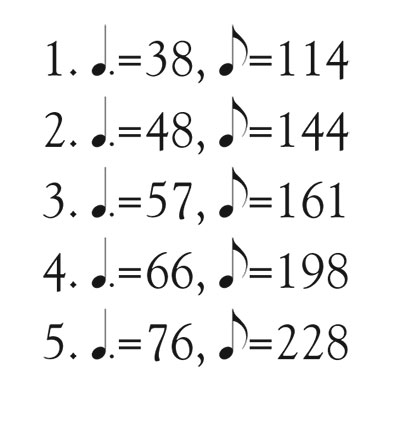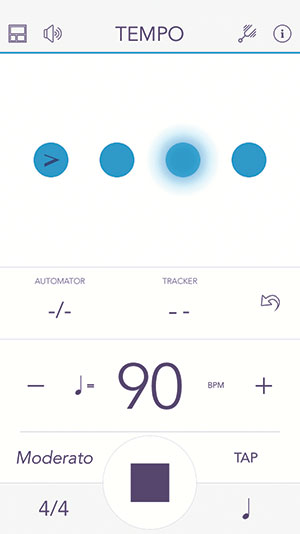Music students learn early on in private lessons that practicing with a metronome is critical. Generally, students are told by their teachers that speeding up slowly, starting from a quite conservative tempo, is one of the most effective ways to keep challenging technical passages from getting sloppy. My method, which I call Terraced Metronome Practice, is the most disciplined and organized way I have ever learned. It speeds up technically demanding music while maintaining accuracy and clarity.
I must give credit to Douglas Humpherys, Chair of the Piano Department at Eastman, who was my piano teacher for six years. Most aspects of this technique came from him. He was – and no doubt still is– an expert at keeping his students’ technique disciplined and clear, serving the music rather than hindering musical expression. While I was a pre-college student, I used the basics of this method regularly to learn my piano music.
As I witnessed the clear benefits of preparing music this way, I transferred the method to flute practice as well. I still use it frequently for any flute music in which I feel my technique has the potential to get imprecise or drag slower than the composer indicated. A perfect example occurs in the Stravinsky Firebird Variation. Every time I pull it out, I religiously practice using this method.
How It Works
The first step is to create a list of working tempos:
1. Determine what the final tempo should be. In the Firebird excerpt, as with many others, this final tempo is provided by the composer. Here it is q.=76. Occasionally a performer, ensemble, or teacher may select a different tempo from what is indicated. In any case, it is important to have a clear, final goal tempo in mind.
2. Figure out half of that tempo. For the Firebird Variation, half tempo is dotted quarter note = 38 – half of 76. One further consideration is that with each practice tempo, it is important to decide on the most helpful way of counting beats. Here, flutists may practice at dotted quarter note = 38, but it is at least equally useful to practice at eighth note = 114. I know that I want to do both.
3. Fill in the intermediate tempo between half tempo and the full tempo goal. This is again a matter of simple mathematics. It will be the expected midpoint between the two tempos. With the Firebird Variation, this means the middle practice tempo is dotted quarter note = 57, or eighth note =171. As a side note, I do prefer to round to numbers on a traditional metronome. Here that would mean 56 and 172, but this is optional.
4. Complete the list of practice tempos by including one more halfway between each of the three found thus far. This generates a list of five tempo goals. Here are five practice tempos for the Firebird Variation:

Put These Five Tempos to Work
Musicians are accustomed to increasing metronome speed as they practice. However, the terraced metronome practice method creates a much more disciplined plan for doing so. Here is how to prepare music using the pre-determined set of five tempos:
1. Work up to the initial half-tempo goal slowly and carefully. You may be able to sightread some parts of the piece at this speed, but other sections may be difficult enough that you have to start at one-third or even one-fourth of the final tempo. Be honest with yourself and start where it is truthfully needed to make the technique perfect. Never move beyond half tempo until you can play whole sections and then the entire piece perfectly at this speed.
2. Once arrived at this point of flawless execution, begin moving towards the second goal tempo (dotted quarter note =48 in the case of Firebird). Remember that not only notes, but everything that should be part of the piece in its final performance version, should be fully prepared. Dynamics, correct articulation, intonation, tone, phrasing, and general expression should all be carefully put in place even at half tempo.
When you are ready to move towards the second tempo, be careful once again not to play any faster than you can keep everything accurate. The technique should remain perfect. If some notes start to be missed, slow down and get everything in place before continuing towards the second tempo goal.
3. Once this second tempo goal has been reached, it will become easy to see how terraced metronome practice differs from simply speeding up the metronome in a more haphazard way. When it feels easy to play a piece perfectly at the first and second goal tempos, do not simply leave those tempos behind while continuing towards the final tempo goal. Each day, begin practicing at the first half-tempo goal. Once you have played perfectly at half tempo – and assuming the goal of playing perfectly at the second tempo has already been reached in the past – move straight to that second tempo stepping stone. After the piece has been played perfectly at these two tempos, move forward carefully towards reaching the third tempo goal.
4. Eventually, it will be possible to play perfectly not just at half tempo, or at the final tempo, but at a range of five tempos. Once perfection (or as near as we can come) is reached at the final tempo, it is crucial to continue checking in with the four slower stepping stone tempos. As familiarity with the piece grows, this does not have to happen every day. However, you should do this at least once or twice every week as you move towards a performance.

Continuing to practice at the slower tempos will ensure that technique does not degenerate or become sloppy as fingers regularly cope with the fastest tempo. It is also much less overwhelming than starting very slowly and progressing through each metronome speed to full tempo every day. Simply be sure that these five discrete tempos can be played to perfection upon demand. When this has been done for several days and then weeks in a row, rest assured that the technique will remain solid under pressure.






